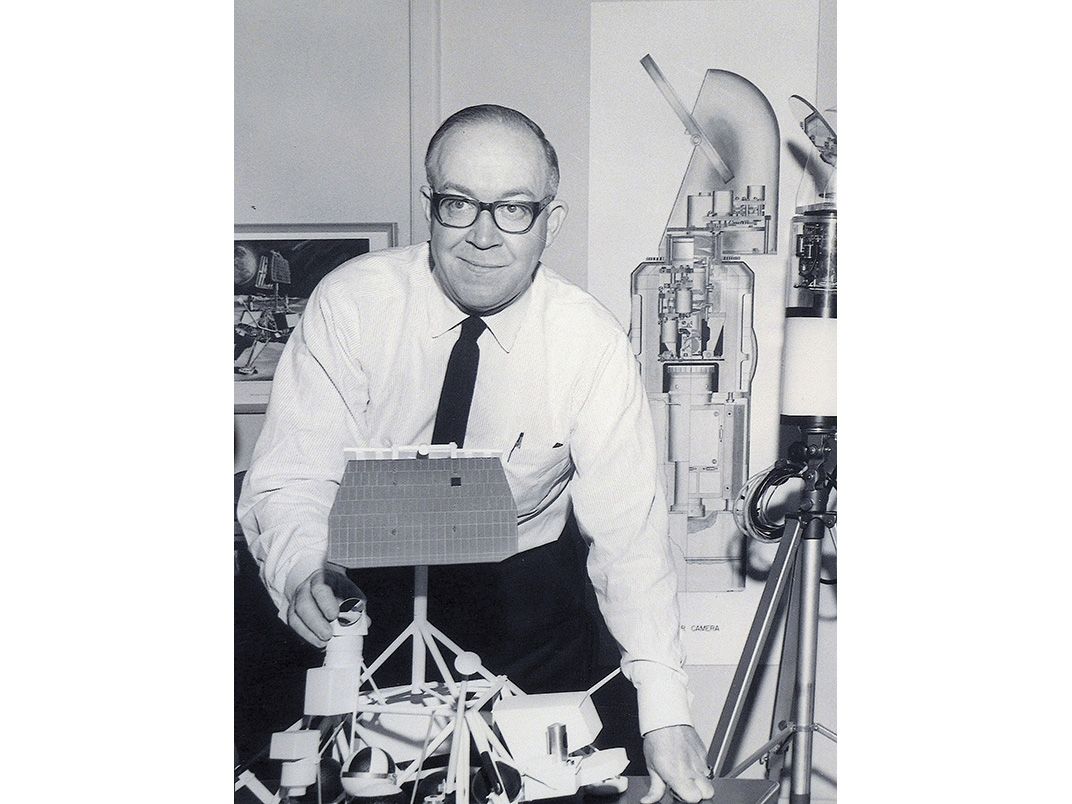My Dad’s Moon Vision
Surveyor I’s Extended Family
/https://tf-cmsv2-smithsonianmag-media.s3.amazonaws.com/filer/95/d3/95d32f98-9ee0-444c-bc12-dc61a2fb3c2e/surveyor_shadow.jpg)
Three years before millions of people around the world watched Neil Armstrong step onto the moon’s surface, I was among a somewhat smaller group looking at televised photos of the surface sent back by the first American spacecraft to land on the moon. On June 2, 1966, when Surveyor I touched down in the lunar Ocean of Storms, I was a 14-year-old with a roomful of model rockets and a dad who worked on the Surveyor program. My father, Frank Mellberg, was the Surveyor project manager at Chicago-based Bell & Howell, which designed and built the zoom lens of the spacecraft’s camera. The sophisticated lens was the primary scientific instrument on Surveyor I. It televised more than 11,000 high-quality images. Those pictures gave scientists their first close look at the lunar surface. The Soviet Union’s Luna-9 had landed on the moon four months earlier but took only a few panoramas, with comparatively low resolution.
Bell & Howell was a subcontractor to Hughes Aircraft Company, which built Surveyor. The Jet Propulsion Laboratory in California managed the project for NASA. When my father met with representatives from Hughes and JPL in 1961 to discuss the contract to produce the lens, they told him about the moon’s vacuum and temperature extremes. “But no one really knew what the moon’s surface was like,” he recalls. “Some scientists thought it was rugged and hard. Others said it was powdery and soft. One man predicted Surveyor would sink into 12 feet of dust. Despite this uncertainty, I had to finish our proposal in less than four days.”
Bell & Howell won the contract, and Dad assembled a team to develop America’s first eye on the moon. Surveyor’s camera was designed to scan the surface after touchdown, providing detailed pictures of rocks, craters, and lunar soil. The lens produced both wide-angle and telephoto images. Counting the number of rotations of the lens gears enabled scientists to determine the sizes and distances of rocks and craters. “We discovered that a last-minute adjustment was needed for Surveyor I’s lens,” he says. “Our testing had been done on Earth. But in a vacuum, the lens would be slightly out of focus. So we had to set the lens slightly out of focus on Earth so that it would be in sharp focus on the moon.”

Building the lens was a challenge. So was the development of the Surveyor spacecraft and its Atlas-Centaur rocket, both of which encountered test failures. I remember that at one point, my dad said, “It’ll never work.” Surveyor I was launched on May 30, 1966. Following a 63-hour journey, the spacecraft began its final approach to the moon. In the Mellberg home, all eyes were glued to our television.Surveyor I made a perfect landing. “I couldn’t believe it,” Dad muses today. “The odds against success were such that I didn’t think the first one would make it. I don’t think anyone did.”
Thirty-six minutes after touchdown, Surveyor I transmitted it first picture, showing a footpad resting firmly on the lunar surface. Additional images revealed a level terrain littered with rocks and craters of all sizes. Mountains could be seen on the horizon.
Four more Surveyor spacecraft touched down on the moon. Apollo 17 geologist-astronaut Harrison Schmitt told me, “Project Surveyor removed any doubt that it was possible for American astronauts to land on the moon and explore its surface.”
In November 1969 the Apollo 12 astronauts landed near Surveyor III. When they returned to Earth, they brought the Surveyor camera with them. It was tested at Bell & Howell’s optical lab about six months later. My father and I both held that camera in our hands. It was a highly emotional experience for Dad. Here was something that spent 31 months on the moon—something he helped create.
The Surveyor III camera, with its Bell & Howell lens, is on permanent display in the National Air and Space Museum.